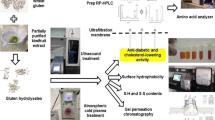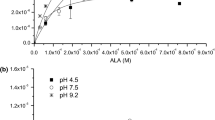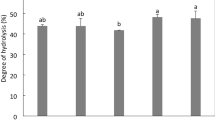Abstract
The aim of this work was to assess the effects of temperature (T), time (t) and pH treatments and an in vitro digestion on the stability of the angiotensin I-converting-enzyme-inhibitory activity (ACEIA) and antithrombotic activity (ATA; assessed as inhibition of platelet aggregation) of selected protein hydrolysates of amaranth named Alb1H103 and GloH88 and GluH24 with dipeptidyl peptidase IV inhibitory activity (DPPIVIA). Heat treatment (40–100 °C) for 1 h showed no significant differences among ACEIA, DPPIVIA and ATA of the heated hydrolysates at pH 4 and 7. There was no statistically significant loss of any bioactivity under heat treatment for 3 h at pH 4.0. Alb1H103 and GluH24 maintained the inhibitory activity of ACE and ATA at pH 7.0 for 3 h, whereas GloH88 maintained ACEIA and ATA for 2.0 h at pH 7.0. The pH effect on hydrolysates bioactivity was assessed in the range of 2.0–12.0. This was negligible on ACEIA, ATA and DPPIVIA. The in vitro digestion was performed using pepsin, trypsin (T) and α-chymotrypsin (C). A previous treatment of hydrolysates with pepsin improved the proteolytic activities of T and C. The hydrolysates kept at 100 °C for 1 h at pH 4.0, showed a significant increase in bioactivity. Conversely, a treatment at pH 7.0 showed no significant difference (p < 0.05) in the hydrolysates bioactivities after their digestion. Thus, biological activity of hydrolysates may be preserved or enhanced, depending on their processing conditions.




Similar content being viewed by others
References
Akilliioglu H, Karakaya S (2009) Effects of treatment and in vitro digestion on the angiotensin converting enzyme inhibitory activity of some legume species. Eur Food Res Technol 229:915–921
AOAC (2010) Official methods of analysis. Association of Official Analytical Chemist, Rockville
Barba de la Rosa AP, Barba Montoya A, Martínez-Cuevas P. Hernández-Ledesma B, León-Galván MF, De León-Rodríguez A, González C (2010) Tryptic amaranth glutelin digest induce endothelial nitric oxide production through inhibition of ACE: antihypertensive role of amarant peptides. Nitric Oxide 23:106–111
Bloom KA, Huang FR, Bencharitiwong R, Bardina L, Ross A, Sampson HA, Nowak-Wegrzyn A (2015) Effect of heat treatment on milk and egg proteins allergenicity. Pediatr Allergy Immunol 25:740–746
Chen J, Wanga Y, Zhong Q, Wua Y, Xiaa W (2012) Purification and characterization of a novel angiotensin-I converting enzyme (ACE) inhibitory peptide derived from enzymatic hydrolysate of grass carp Protein. Peptides 33:52–58
Condés MC, Scilingo AA, Añón MC (2009) Characterization of amaranth proteins modified by tripsin proteolysis: structural and functional changes. Food Sci Technol 42:963–970
De la Peña A, Baños G, Izaguirre R, Mandoki JJ, Fernández-G JM (1993) Comparative effect of synthetic amino-estrogens with estradiol on platelet aggregation. Steroids 58:407–409
Dexter AF, Middelberg PJ (2008) Peptides as functional surfactants. Ind Eng Chem Res 47:6391–6398
Domínguez-González K, Cruz-Guerrero A, González-Márquez H, Gómez-Ruiz L, García-Garibay M, Jiménez-Guzmán J, Rodríguez-Serrano G (2014) Antihypertensive and antithrombotic activities of a commercial fermented milk product made with Lactobacillus casei Shirota and Streptococcus thermophillus. Int J Dairy Technol 67:358–362
Flores-Garcia M, Fernández-G JM, León-Martínez M, Hernández-Ortega S (2012) The structures and inhibitory effects of Buame [N-(3-hydroxy-1,3,5(10)-estratrien-17β-yl)-butylamine] and Diebud [N,N 0-bis-(3-hydroxy-1,3,5(10)-estratrien-17β-yl)-1,4-butanediamine] on platelet aggregation. Steroids 77:512–520
Fritz M, Vecchi B, Rinaldi G, Añón MC (2011) Amaranth seed protein hydrolysates have in vivo and in vitro antihypertensive activity. Food Chem 126:878–884
Fu Y, Young JF, Dalsgaard TK, Therkildsen M (2015) Separation of angiotensin I-converting enzyme inhibitory peptides from bovine connective tissue and their stability towards temperature, pH and digestive enzymes. Int J Food Sci Technol 50:1234–1243
González G, Alvarado-Vasquez N, Fernández-G JM, Cruz-Robles D, del Valle L, Pinzón E, Torres I, Rodríguez E, Zapata E, Gómez-Vidales V, Montaño LF, de la Peña A (2010) The antithrombotic effect of the aminoestrogen prolame (N-(3-hydroxy-1,3,5(10)-estratrien-17B-YL)-3-hydroxypropylamine) is linked to an increase in nitric oxide production by platelets and endothelial cells. Atherosclerosis 208:62–68
Hayakari M, Kondo Y, Izumi H (1978) A rapid and simple spectrophotometric assay of angiotensin-converting enzyme. Anal Biochem 84:361–369
Hejgaard J, Dam J, Petersen LC, Bjorn SE (1994) Primary structure and specificity of the major serine proteinase inhibitor of amaranth (Amaranthus caudatus L.) seeds. Biochim Biophys Acta 1204:68–74
Huang SL, Jao CL, Ho KP, Hsu KC (2012) Dipetidyl-peptidase IV activity of peptides derived from tuna cooking juice hydrolysates. Peptides 35:114–121
Hwang JS (2010) Impact of processing on stability of angiotensin I-converting enzyme (ACE) inhibitory peptides obtained from tuna cooking juice. Food Res Int 43:902–906
Kojima K, Ham T, Kato T (1980) Rapid chromatographic purification of dipeptidyl peptidase IV in human submaxillary gland. J Chromatogr A 189:233–240
Kristinsson HG, Hultin HO (2003) Effect of low and high pH treatment on the functional properties of cod muscle proteins. J Agric Food Chem 51:5103–5110
Li GH, Le GW, Shi YH, Sherstha S (2004) Angiotensin I-converting enzyme inhibitory peptides derived from food proteins and their physiological and pharmacological effects. Nutr Res 24:469–486
Madureira AR, Tavares T, Gomes AMP, Pintado ME, Malcata FX (2010) Physiological properties of bioactive peptides obtained from whey proteins. J Dairy Sci 93:437–455
Montoya-Rodriguez A, Gómez-Favela MA, Reyes-Moreno C, Milán-Carrillo J, González de Mejía E (2015) Identification of bioactive peptide sequences from amaranth (Amaranthus hypochondriacus) seed proteins and their potential role in the prevention of chronic diseases. Compr Rev Food Sci Saf 14:139–156
Orsini DMC, Tironi VA, Añón MC (2011) Antioxidant activity of amaranth protein or their hydrolysates under simulated gastrointestinal digestion. Food Sci Technol 44(1752):1760
Rao S, Sun J, Liu Y, Zeng H, Su Y, Yan Y (2012) ACE inhibitory peptides and antioxidant peptides derived from in vitro digestion hydrolysate of hen egg white lysozyme. Food Chem 135:1245–1252
Rui X (2012) Angiotensin I-converting enzyme inhibitory properties of Phaseolus vulgaris bean hydrolysates: Effects of different thermal and enzymatic digestion treatments. Food Res Int 49:739–746
Sabione AC, Scilingo A, Añon MC (2015) Potential antithrombotic in amaranth proteins and its hydrolysates. Food Sci Technol 60:171–177
Sheih IC, Fang TJ, Wub TK (2009) Isolation and characterization of a novel angiotensin I-converting enzyme (ACE) inhibitory peptide from the algae protein waste. Food Chem 115:279–284
Shevkani K, Singh N (2015) Relationship between protein characteristics and film-forming properties of kidney bean, field pea and amaranth protein isolates. Intl J Food Sci Technol 50:1033–1043
Shevkani K, Singh N, Kaur A, Rana JC (2014a) Physicochemical, pasting, and functional properties of amaranth seed flours: effects of lipid removal. J Food Sci 79:C1271–C1277
Shevkani K, Singh N, Rana JC, Kaur A (2014b) Relationship between physicochemical and functional properties of amaranth (Amaranthus hypochondriacus) protein isolates. Food Sci Technol 49:541–550
Soriano-Santos J, Escalona-Buendía HB (2015) Angiotensin I-converting enzyme inhibitory and antioxidant activities and surfactant properties of protein hydrolysates as obtained of Amaranthus hypochondriacus L. grain. J Food Sci Technol 52:2073–2082
Soriano-Santos J, Reyes-Bautista R, Guerrero-Legarreta I, Ponce-Alquicira E, Escalona-Buendía HB, Almanza-Pérez JC, Díaz-Godínez G, Román-Ramos R (2015) Dipeptidyl peptidase IV inhibitory activity of protein hydrolyzates from Amaranthus hypochondriacus L. grain and their influence on postprandial glycemia in streptozotocin-induced diabetic mice. Afr J Tradit Complement Altern Med 12:90–98
Tavares T, Contreras M, Amorim M, Pintado M (2011) Novel whey-derived peptides with inhibitory effect against angiotensin-converting enzyme: In vitro effect and stability to gastrointestinal enzymes. Peptides 32:1013–1019
Tovar-Pérez EG, Guerrero-Legarreta I, Farrés-González AN, Soriano-Santos J (2009) Angiotensin I-converting enzyme-inhibitory peptide fractions from albumin 1 and globulin as obtained of amaranth grain. Food Chem 116:437–444
Valdes-Rodriguez S, Segura Nieto M, Chagolla-Lopez A, Verver-y Vargas-Cortina A, Martinez-Gallardo N, Blanco-Labra A (1993) Purification, characterization, and complete amino acid sequence of a trypsin inhibitor from Amaranth (Amaranthus hypochondriacus) seeds. Plant Physiol 103:1407–1412
Velarde-Salcedo AJ, Barrera-Pacheco A, Lara-González S, Montero-Morín G, Díaz-Gois González, de Mejía E, Barba de la Rosa AP (2013) In vitro inhibition of dipeptidyl peptidase IV by peptides derived from the hydrolysis of amaranth (Amaranthus hypochondriacus L.) proteins. Food Chem 136:758–764
Wu J, Ding X (2002) Characterization of inhibition and stability of soy protein derived angiotensin I-converting enzyme inhibitory peptides. Food Res Int 35:367–375
Wu W, Feng-yang Z, Hong-xia CH, Zhan-mei J (2014) Stability and cytotoxicity of angiotensin-I-converting enzyme inhibitory peptides derived from bovine casein. J Zhejiang Univ-Sci B 2:143–152
Acknowledgements
We are grateful to Prof. Abraham Avendaño-Martínez for proofreading and translating the manuscript.
Author information
Authors and Affiliations
Corresponding author
Rights and permissions
About this article
Cite this article
López-Sánchez, J., Ponce-Alquicira, E., Pedroza-Islas, R. et al. Effects of heat and pH treatments and in vitro digestion on the biological activity of protein hydrolysates of Amaranthus hypochondriacus L. grain. J Food Sci Technol 53, 4298–4307 (2016). https://doi.org/10.1007/s13197-016-2428-0
Revised:
Accepted:
Published:
Issue Date:
DOI: https://doi.org/10.1007/s13197-016-2428-0




